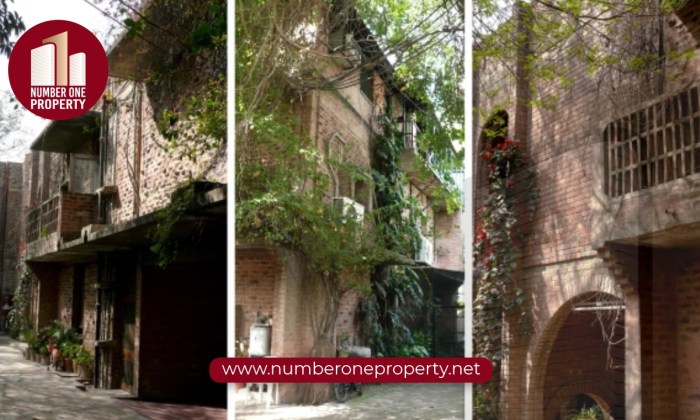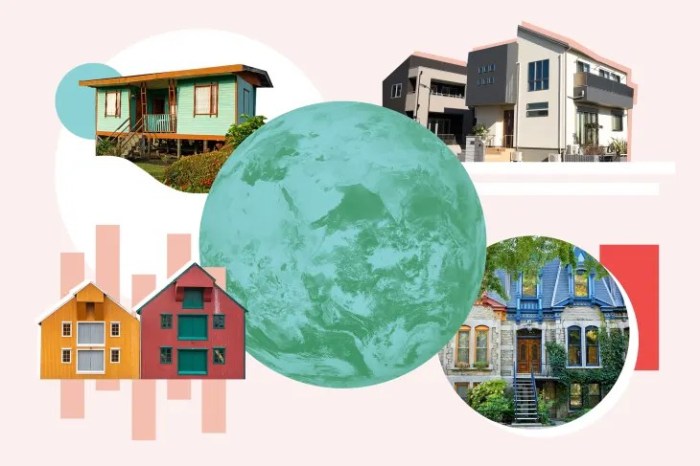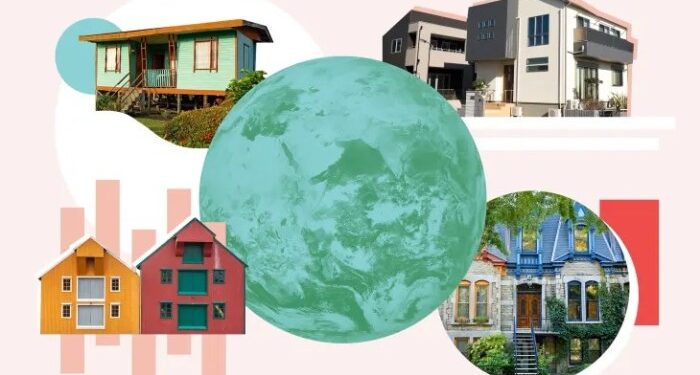Embark on a fascinating journey through the intricate tapestry of Cultural Influences in Residential Design Across Continents. From traditional heritage to modern innovations, this topic delves into the rich diversity that shapes architectural landscapes worldwide.
As we unravel the key elements influencing residential design globally, we uncover the intricate interplay of culture, history, and creativity that define homes across different continents.
Cultural Influences in Residential Design Across Continents

In the realm of residential design, various cultural elements play a significant role in shaping the architecture and construction of homes across different continents. These influences stem from historical traditions, societal values, climate considerations, and material availability, among other factors.
Key Cultural Elements Shaping Residential Design
In examining the global landscape of residential design, it becomes apparent that cultural elements such as religious beliefs, social structures, and lifestyle preferences greatly influence the architectural styles and layouts of homes. For example, in the Middle East, traditional Islamic architecture emphasizes privacy with interior courtyards and intricate geometric patterns, reflecting the cultural value of modesty and community.
In contrast, Scandinavian countries prioritize minimalism and functionality in design, reflecting their cultural emphasis on simplicity and sustainability.
Historical Traditions Impacting Residential Architecture
Historical traditions have a lasting impact on residential architecture in different continents. For instance, in Europe, the influence of ancient Roman and Greek architectural styles can still be seen in the columns, arches, and symmetrical designs of many residential buildings.
In Asia, the principles of Feng Shui guide the layout and orientation of homes to promote harmony and balance, reflecting ancient Chinese beliefs in the connection between humans and the environment.
Use of Materials in Residential Construction
The choice of materials in residential construction varies based on cultural influences and local availability. In Africa, mud brick and thatch roofs are commonly used in traditional homes due to their abundance and natural insulating properties. In North America, wood is a popular material for residential construction, reflecting a historical reliance on forests for building materials and a preference for its aesthetic appeal.
Asian Cultural Influences in Residential Design
Asian residential design is heavily influenced by cultural practices and beliefs that have been passed down through generations. One of the most prominent influences in Asian residential design is the practice of feng shui, which emphasizes the flow of energy in a space and the arrangement of furniture to promote harmony and balance.
Influence of Feng Shui on Residential Architecture
Feng shui dictates the placement of furniture, the orientation of rooms, and the use of specific colors to create a harmonious living environment. For example, in Chinese culture, the front door is considered the mouth of chi (energy), and its positioning can impact the flow of energy in the home.
This belief often leads to the design of homes with strategically placed entrances and windows to allow for the smooth flow of energy.
Significance of Open Spaces and Natural Elements
Asian residential design often incorporates open spaces and natural elements such as water features, gardens, and indoor plants. These elements are believed to promote tranquility and connection to nature, which are important aspects of Asian culture. Additionally, the use of natural materials like wood, bamboo, and stone is common in Asian interiors to bring a sense of warmth and harmony to the space.
Use of Colors and Symbolism in Asian Residential Interiors
Colors hold significant meaning in Asian cultures, and this is reflected in residential design. For example, red is often used to symbolize happiness and good fortune in Chinese culture, while white represents purity and simplicity in Japanese culture. These colors are strategically incorporated into interior design through furniture, textiles, and decor to evoke specific emotions and meanings within the space.
European Cultural Influences in Residential Design
European residential architecture has been greatly influenced by historical periods such as Baroque and Renaissance. These periods have left a lasting impact on the design and structure of homes across Europe.
Baroque and Renaissance Influence
The Baroque and Renaissance periods in Europe have influenced residential architecture with their grand and ornate styles. Baroque architecture is known for its dramatic use of light and shadow, intricate detailing, and elaborate decorations. On the other hand, Renaissance architecture emphasizes symmetry, proportion, and classical forms.
These influences can be seen in the grand facades, elaborate moldings, and decorative elements of many European homes.
Sustainability and Eco-Friendly Design
Modern European homes are increasingly incorporating sustainability and eco-friendly design principles. From energy-efficient appliances to green building materials, homeowners in Europe are prioritizing environmentally friendly practices in their residential design. Features like solar panels, rainwater harvesting systems, and green roofs are becoming more common in European homes, reflecting a growing concern for sustainability.
Key Features of European Interior Design Styles
European interior design styles like Scandinavian, Mediterranean, and French each have their own unique characteristics. Scandinavian design is known for its minimalistic approach, natural materials, and neutral color palettes. Mediterranean design features warm colors, rustic elements, and influences from the sea and sun.
French design exudes elegance, luxury, and ornate detailing, with a focus on classic and timeless pieces. These interior design styles showcase the diversity and richness of European cultural influences in residential design.
African Cultural Influences in Residential Design
Africa's diverse cultures and traditions have a significant impact on residential design across the continent. From tribal influences to vibrant decor choices, African homes reflect a rich tapestry of history and artistry.
Tribal Traditions and Craftsmanship
In African residential design, tribal traditions play a crucial role in shaping architectural styles and building techniques. Many homes are constructed using traditional materials such as mud bricks, thatch, and wood, showcasing the craftsmanship and skills passed down through generations.
The unique architectural features, like thatched roofs and decorative carvings, are often inspired by tribal rituals and beliefs, adding a cultural significance to the design.
Vibrant Colors, Patterns, and Textures
African home decor is known for its use of vibrant colors, bold patterns, and rich textures. From intricately woven textiles to hand-painted murals, every element in the interior design reflects the cultural identity of the inhabitants. Bright hues like red, orange, and yellow are commonly used to create a warm and inviting atmosphere, while geometric patterns and tribal motifs add a sense of tradition and heritage to the space.
Integration of Outdoor Living Spaces
African residential design often blurs the boundaries between indoor and outdoor living, emphasizing a connection to nature and the surrounding environment. Courtyards, verandas, and covered outdoor spaces are seamlessly integrated into the architecture, providing a place for social gatherings, relaxation, and communal activities.
This design approach allows residents to fully embrace the beauty of the landscape while enjoying the comfort of their homes.
North and South American Cultural Influences in Residential Design
Residential design in North and South America is a fascinating blend of indigenous traditions, colonial influences, and modern design elements. Let's explore the unique cultural influences that have shaped homes in these regions.
Indigenous Cultures on Residential Design
Indigenous cultures have had a significant impact on residential design in both North and South America. In North America, Native American tribes such as the Navajo, Hopi, and Pueblo have influenced architectural styles with their use of natural materials, earth-toned color palettes, and interconnected living spaces.
In South America, civilizations like the Inca and Maya have left a legacy of stone structures, terraced homes, and sustainable building practices that continue to inspire modern architects.
Colonial Architecture Influence
The colonial period in the Americas brought European architectural styles to the forefront, influencing residential design in both North and South America. Spanish Colonial homes with their stucco walls, red-tile roofs, and central courtyards can be seen throughout the Southwest United States and Latin American countries.
Similarly, Portuguese Colonial homes in Brazil showcase ornate facades, colorful tiles, and tropical influences that have become iconic in residential design.
Blending Modern and Traditional Elements
A growing trend in American homes is the blending of modern design elements with traditional architectural features. This fusion of styles creates a unique aesthetic that pays homage to the past while embracing contemporary living standards. For example, modern homes in North America may incorporate Native American motifs, such as geometric patterns or natural materials, into sleek and minimalist designs.
In South America, colonial-era homes are being renovated with modern amenities while preserving historical elements like wooden beams or arched doorways.
Closing Notes

In conclusion, Cultural Influences in Residential Design Across Continents showcases the dynamic fusion of tradition and innovation, offering a glimpse into the vibrant mosaic of architectural styles that grace our neighborhoods.
FAQ Corner
How do historical traditions impact residential architecture in different continents?
Historical traditions play a significant role in shaping residential architecture by influencing design elements, construction techniques, and architectural styles unique to each continent.
What is the significance of open spaces and natural elements in Asian residential design?
Open spaces and natural elements in Asian residential design are valued for promoting harmony, balance, and a connection to nature, reflecting cultural beliefs and traditions.
How do tribal traditions and craftsmanship influence African residential architecture?
Tribal traditions and craftsmanship in Africa contribute to the vibrant colors, patterns, and textures seen in home decor, showcasing a rich cultural heritage in architectural design.
What trends are emerging in blending modern and traditional design elements in American homes?
A growing trend in American homes involves blending modern amenities with traditional design elements to create unique living spaces that honor heritage while embracing contemporary comforts.


